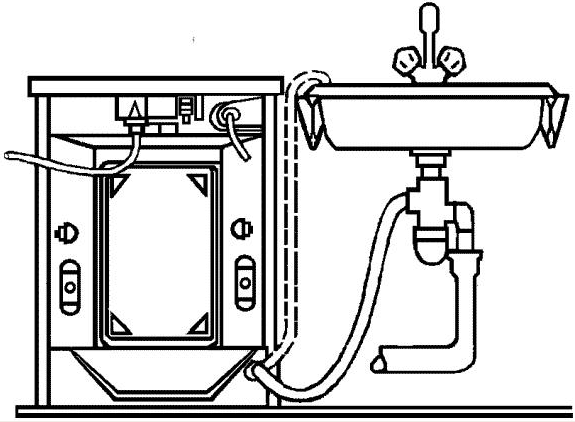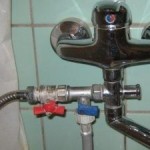Step-by-step instructions for connecting the washing machine
Necessary materials
Before you decide to install a washing machine, we recommend that you purchase the following materials:
- Siphon. Through it, you need to connect the drain hose to the sewer pipe.
- A flexible hose in a metal braid for cold water (3/4 inches) and a polyethylene hose for discharge. Typically, short hoses are included, which in individual conditions may not reach the connection point.
- Plastic pipe tee with shut-off valve (3/4 inch).
- Three-core wire with a cross section of at least 2.5 mm2 For an outlet through which the washing machine will be connected to electricity. If the wire is of a smaller cross section, overload and spontaneous combustion may occur. Better to implement cable section calculation in this case.
- Circuit breaker on 16A and RCD (or two in one - difavtomat). Protect you from electric shock, and equipment from failure.
Preparatory work
If you are just going to purchase this type of equipment and just decided in advance to get acquainted with the connection information, we recommend that you look at the detailed instructions for choosing a washing machine for home. When the purchased equipment will already be in the house, it is necessary to choose the most suitable installation location.
A modern solution would be to install a washing machine in the following places:
- Under the sink in the bathroom. Thus, you can save free space if there is not enough space in the bathroom.
- In the kitchen (built-in option under the countertop). Again, suitable if the size of the bathroom is too small.
- In the hall. It is recommended to install a washing machine in this place if all the necessary communications are connected through the wall in the room.
Having decided on the installation location of the washing machine, it is necessary to prepare the surface and print the equipment.Further, transportation bolts are unscrewed from the back cover, preventing the rotation of the drum during its transportation from the store to the house. In addition to bolts, protective bars and staples can also be installed, which must be removed.
If you do not remove all shipping parts and turn on the connected machine, it will very quickly fail, having received serious damage to the internal mechanism.
Do not forget to plug the holes from the unscrewed bolts with special plastic plugs that come with the kit. After this, you need to unscrew the legs to expose the body strictly in a horizontal position. Everything is simple here, release the nut that presses the leg to the body, then unscrew the leg to the required distance and tighten the upper nut until it stops. When the equipment is installed in its place, you need to move on to the main process.
You might also be interested in reading about how to install a tumble dryer on a washing machine. We provided installation instructions in a separate article!
Bring cold water
To begin with, it is necessary to carry out the most labor-intensive measure - to connect the washing machine to the water supply.
To make it easier for you, we provide step-by-step instructions for connecting the washing machine to cold water:
- Choose a connection point. It is best to use the area where the plastic pipe connects to the flexible hose of the mixer, although you can even connect to a faucet in the shower.
- Unscrew the flexible hose.
- We install a tee, after winding the fumlent on the thread.
- Again, after wrapping the fumlent on the other two threads of the tee, you need to connect flexible hoses from the washbasin faucet and the washing machine itself.
- Carefully tighten all threaded connections with a wrench
Be sure to check that there are o-rings at both ends of the inlet hose to prevent water from leaking at the joints!
Bring the drain
Everything is much simpler here and the connection process itself takes no more than 5 minutes.
First you need to install a siphon under the sink, which will prevent the spread of unpleasant odors from the sewer. Next, you need to connect the drain hose to a special hole in the back cover of the unit. Closer to the top of the back cover you will see a special plastic bracket for fixing the drain hose. If it is not fixed, water will flow by gravity from the unit. The second end of the hose is connected to the siphon (as shown in the photo), after which we check the connection points of the washing machine to the drain.
You can make a temporary drain by placing the output in the sink, toilet or bathroom, securing it to a special bracket that comes with the kit. We strongly recommend not using this option as a stationary one, as this will cause many inconveniences of using the bathroom.
We connect to the power supply
Everything can be quite simple here only if your home wiring is suitable for using such powerful household appliances.
It is enough just to connect the washing machine to the outlet in the following cases:
- You independently calculated the wiring and made sure that the input cable can withstand the required loads;
- wiring in a private house has grounding (which is mandatory);
- the outlet group in the bathroom is protected by a circuit breaker or difavtomatom.
An important requirement is that in the old house it is necessary to replace the wiring, add protective devices to the circuit and be sure to bring the grounding contact.
The diagram of the correct connection of the washing machine to the network is:
As you can see, the electrical circuits are quite simple and even a kettle in an electrician can figure out the connection. This is all the technology of installing a washing machine with your own hands. We also advise you to watch a visual video lesson of the whole event and some useful tips provided below.
Useful tips from experts
There are many options for how to connect the washing machine to the water supply, sewer and mains. Some of them are not correct and can shorten the life of the equipment and negatively affect your health. To prevent this from happening, readers "our.electricianexp»Provide some important tips:
- In no case do not connect the grounding contact to the radiators or gas and water supply lines.
- Instead of fumlent, you can also use flax and paste, which no less effectively block leakage.
- Few people know, but a washing machine can be connected not only to the central water supply, but also to an ordinary water barrel. All you need is to position the tank at least 4 meters above the equipment itself. A distance of 1 meter will give a pressure of 0.1 atmosphere, while 0.4 atmosphere will be enough for the machine to function even without a pump. This idea is often used in a village in the country, where the water supply is unstable or there is no water supply at all (well or well).
- Expose the building according to the building level. The slightest distortion will cause vibration.
- Do not place pieces of rubber or linoleum under the legs. Adjust the height only by unscrewing / twisting. Substrates will also adversely affect the vibration of the equipment during centrifuge operation. Even if the floor is uneven so that the washing machine does not jump, correctly adjust the legs.
- Do not discard the transport bolts, as they can be useful in the future (for example, if you move to take all your equipment to a new place of residence).
- When installing a temporary drain, note that the hose may fall out of the bathroom (which happens very often) and flood your neighbors. If even a short hose is not enough, it is better to go to a plumbing shop for a new, more authentic one, after which it is correct to connect the washing machine to the water supply and drain.
That's the whole technology of installing and connecting a washing machine with your own hands. We hope that the information was interesting and useful for you!
Similar materials:























A height of 1 meter gives a water pressure of 0.1 atmosphere.